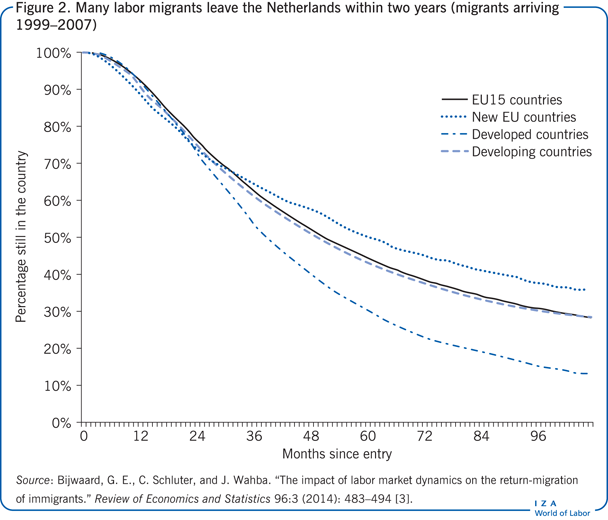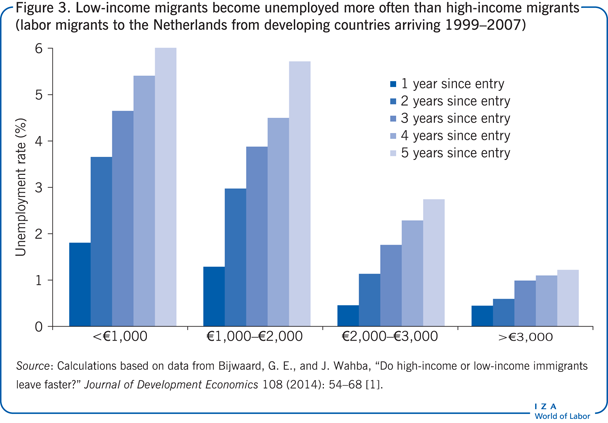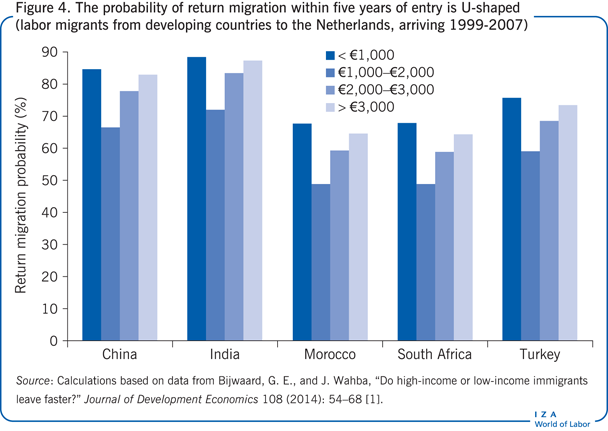Elevator pitch
The majority of immigrants stay only temporarily in the host country. When many migrations are temporary, it is important to know who leaves and who stays, and why. The key questions for the host country are whether immigrants are net contributors to the welfare system and whether migrants assimilate quickly. The key questions for the home country are whether migrants return and who returns. The host country gains when unsuccessful migrants leave, while the home country may gain when successful migrants leave. Empirical evidence reveals that both low-income-earning and high-income-earning migrants leave the host country quite soon.
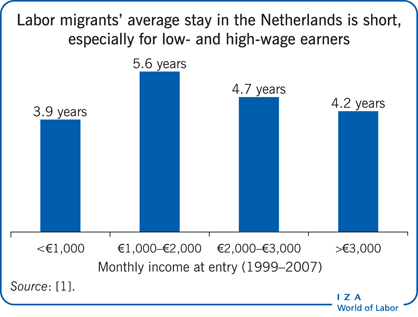
Key findings
Pros
Many migrants stay only temporarily. Theoretically, the effect of higher wages on the duration of migration is ambiguous, making it an empirical question.
Low-income migrants leave sooner when they fail to find adequate work.
Outmigration of low-income migrants reduces the fiscal burden on the host economy.
Return of high-income migrants reduces brain drain in the home country.
Income is a key factor affecting return migration, in particular for labor migrants.
Cons
Labor market status affects both wages and migration duration.
High-income immigrants leave faster when they are target savers, but not as fast as low-income migrants.
Outmigration of high-income migrants is a fiscal loss to the host economy.
It is unclear whether migrants who leave return home or move to another host country.
Income may not be the main determinant of return migration, especially for non-labor migrants.
Author's main message
Both unsuccessful and successful migrants to developed countries stay a short time. Many leave when they become unemployed, or earn no or low income. That implies that concern that host countries are being burdened by welfare seekers is unfounded. The rapid departure of successful migrants implies that concerns about brain drain from developing to developed countries might be exaggerated, as many high-income migrants leave soon. But this means that the host country loses high-potential immigrants. Policy in the host country therefore needs to focus not only on attracting the best immigrants but also on retaining them.
Motivation
How well immigrants perform in the labor market is of key interest to host countries and provides valuable information for migration policies. Many migrants from developing countries to developed countries stay only temporarily (Figure 1), and the decision to leave is likely related to their labor market participation and their wage in the host country. Theoretically, the effect of wages on return migration is ambiguous [1]. On the one hand, in response to higher wages, migrants would like to remain in the host country. On the other hand, the gain from returning may increase for migrants who have amassed savings and gained experience in the host country. As a consequence, higher wages abroad could have a positive or a negative effect on migration duration.
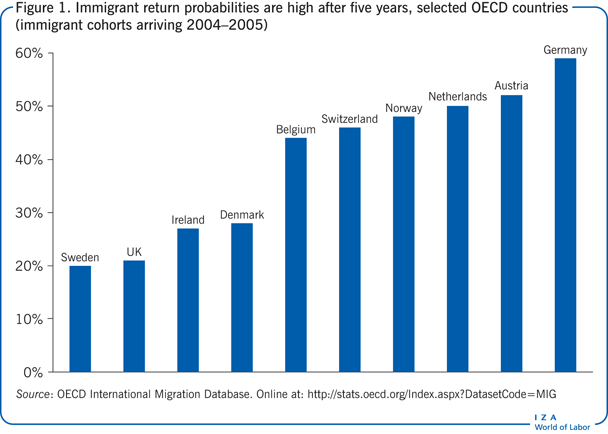
The impact of wages on the duration of stay also has important policy implications. When immigrants with low wages stay longer, their fiscal burden on the host country increases, as low-wage migrants more often become unemployed. When immigrants with high wages stay longer, that implies a brain drain for the home country, as high wage earners are mostly highly skilled migrants. This paper presents evidence that both low- and high-wage immigrants leave relatively soon, so that these policy concerns are unwarranted.
Discussion of pros and cons
Migration flows have typically been explained by differences in wage and employment differentials between home and host countries. Considering the large and persistent wage and unemployment gaps between most developing countries and developed countries, these conventional migration theories are unable to explain the rather small size of migration flows and the presence of extensive return migration. The level of return migration has been high in both Europe and the US. For example, about 20–50% of immigrants to the Netherlands leave [2]. Labor migrants and foreign students leave the fastest, while family migrants remain more often in the host country [2]. Most of the literature on migration has, at least implicitly, focused on labor migrants. Many of the labor migrants to the Netherlands leave within two years of arrival, and others continue to leave thereafter (Figure 2) [3].
Ignoring this dynamic nature of migration hampers the assessment of the integration of migrants by overlooking the fact that many migrants return to their home country, or move on to another country, within a fairly short time after arrival. When many migrations are temporary and the less successful migrants tend to re-migrate, then integration of migrants will appear to rise with the duration of residence, even though the integration of individual migrants may not rise. If, however, more successful migrants re-migrate and do so faster than other migrants, then the results may be biased in the opposite direction. The implications of return migration for the home country are usually the opposite of these. When unsuccessful migrants return, the home country will suffer; when successful migrants return, the home country will gain. However, migrants who leave one host country may move to a third country rather than returning home, with the same implications for the home country as for the (original) host country.
Why migrants return
The literature offers a few theoretical explanations for temporary migration. An obvious, but empirically not very relevant, reason is that the labor market in the home country has improved relative to that in the host country. Return migration may have been planned from the outset or may be an outcome of imperfect information about the opportunities in the host country [4]. Reasons for planned return migration include preference for the home country, faster skill acquisition in the host country, and target saving plans.
Migrants may have a preference for consumption in their home country [5]. Even migrants who are indifferent between living and consuming in the host or the home country may decide to return home if prices there are considerably lower. In that case, re-migration is beneficial to the migrant because it allows them to accumulate savings in the high-wage country and spend them in the low-price country. A higher price level in the host country also stimulates the migrant to consume less in the host country and more in the home country after return. Planned return can also be induced when the migrant acquires skills in the host country that boost earnings in the home country more than in the host country, whether through employment or entrepreneurship. Returning home may also be a way to overcome credit constraints in the host country. A final planned reason for return migration is that the migrant has only temporary permission to stay in the host country, for example, only for the duration of a work contract. When the permission expires, the migrant leaves the host country.
The most relevant unplanned shock that may induce return migration is the inability to find a job or the sudden loss of a job. Migrants do not automatically qualify for unemployment and other social welfare benefits in the host country, and with low or no income, the migrant has little choice but to return home.
Who returns
The most important determinant of whether migrants are positively selective (more skilled and educated than average in the home country) or negatively selective (less skilled and educated than average) is the spread of the earnings distribution in the host and home countries [4]. If the wage distribution has less variability in the host country than in the home country, migrants are negatively selected (assuming transferability of skills), and this negative selection is reinforced by return migration. This holds for migration flows from developing countries to western Europe, as most European host countries have a rather fair wage distribution, while most developing countries have large wage inequalities. If migrants are positively selected, then return migrants tend to be the worst of the best. If migrants are negatively selected, then return migrants tend to be the best of the worst. When the focus is on the income of migrants, positive selection implies that immigrants are from the upper part of the income distribution at home and that returnees are from the lower part of the (immigrant) income distribution in the host country.
It is obvious that income in the host country plays an important role in the return decision. Migrants who have planned to return home after they accumulate a certain amount of savings in the host country generally return home after they reach their target [5]. This kind of motivation implies that high-income-earning migrants leave earlier, because they can accumulate savings faster. When return migration is driven by unexpected events, such as unemployment, returnees are mainly low-income migrants. This has important implications for both the host and the home country.
Implications for the host country
Immigrants, when they first arrive in a country, often lack country-specific human capital, such as knowledge about the labor market and local language skills. More time spent in the host country is assumed to lead to more human capital investment, which is likely to increase the productivity of immigrants and enable them to progress up the earnings ladder. An important aspect affecting immigrant behavior is that decisions on return migration are usually made in conjunction with economic decisions related to the migrant’s participation in the labor market. Thus, the return decision might be endogenously determined with adverse or positive labor market events such as the occurrence of unemployment spells and re-employment spells [3] and the amount of income earned [1]. Once these selection issues are accounted for, the impact of return migration on the host country can be deduced. If unsuccessful migrants, with a low income or who are unemployed, leave fairly quickly, the burden on the welfare system of the host country is less than perceived. If successful migrants, with a high income, leave quickly, the host country loses some of the potential gains of immigration.
Implications for the home country
Development economists have emphasized that migration from developing countries to developed countries may lead to a flight of highly skilled people from developing countries (brain drain). Indeed, migrants from developing countries are usually more educated than the average resident of the home country.
Immigration policies in Europe and the US have stimulated such brain drain by simplifying entrance for highly educated individuals while making it more difficult for migrants with less potential to acquire a visa. However, in recent years both theoretical models and empirical results have shown that migration of skilled individuals from developing countries might benefit the home country. Whether such migration leads to a brain drain or a brain gain is determined largely by who returns. If migrants acquire human capital in the host country that is also valued in the home country and if people with a higher income return, migration may be beneficial from the home country’s perspective. If, however, the returnees are the less successful migrants, return migration does not offset—and may even intensify—the initial negative selective outmigration. Of course, it is also possible that outmigration from the host country is onward migration to a third country instead of return migration. Then, the gains for the home country depend on who returns home and who moves on.
Empirical evidence on the impact of migrant income on return
Data limitations are the main reason that the temporary nature of migration has been ignored in the empirical literature. The more recent availability of large comprehensive administrative data sets, covering the whole resident population and recording immigrant entries and departures, has made possible the analysis of temporary migration dynamics. Administrative data sets avoid the problems of selectivity and attrition that are often inherent in survey data and that are particularly acute in studies of migration dynamics since having people drop out of the survey confounds the observation of these processes.
Empirical work investigating the impact of migrant income on the return decision is rather limited. Some studies find a positive relation between income earned in the host country and the return decision. For migrants to the US, higher earnings are associated with less return migration [6]. A similar result is found for the return decision of Philippine migrants induced by the Asian financial crisis of 1997–1998 [7]. However, for temporary migrants to Germany, the optimal duration of their stay decreases as their wages rise, despite persistently higher wages in Germany than in the home country, based on a rational expectations model for calculating optimal migration duration [8]. In Sweden, immigrants who re-emigrate have higher adjusted mean income levels in general, up to the age of 35–40, than immigrants who do not; propensities to re-migrate are U-shaped with respect to (lagged) income, implying a higher probability of emigration for immigrants with low or with high incomes [9].
A few studies find no income effect on return migration. For example, for migrants to Germany, no statistically significant relationship is found between earnings and migrant return, although migrants who are unemployed are more likely to return [10]. For top-performing emigrants from three Pacific countries, analysis finds that the decision to return is strongly linked to family and lifestyle rather than to the income opportunities in host countries [11].
A major methodological concern with the empirical work on the relation between earnings in the host country and return migration decisions is that the earnings in the host country depend on migrant characteristics [1], [6]. This implies that any observed relationship between earnings in the host country and return migration may be caused by unobserved factors that influence both the wage growth and the return migration decision. For example, a finding that low-income migrants remain for less time in the host country may not imply that low wages cause migrants to leave sooner. Rather, that decision may be induced by other characteristics of low-wage migrants that lead to a shorter stay. Labor market behavior in the host country plays a central role. Unemployment is shown to affect the return decision [3], [12].
Studies therefore need to account for the interdependence between labor market changes and return. Two ways to deal with this interdependence are to use natural or quasi-experiments, such as the unexpected exchange rate shocks due to the 1997–1998 Asian financial crisis [7], and a timing-of-events model, which explicitly controls for the strong correlation between labor market changes and the return migration rate [3]. Only after accounting for this interdependence is it possible to estimate the casual impact of unemployment on return migration [3].
An empirical study using a model that takes the interdependence of labor market status and income earned into account reveals that return migration is U-shaped with respect to initial income: return rates are highest for both low- and high-income groups, with the lowest-income group exhibiting the highest return [1]. The study argues that low-income migrants return sooner because they have failed in the labor market, and that high-income migrants leave sooner because they have successfully met their target savings or acquired their desired skills.
The analysis is based on an administrative panel data set of recent (1999–2007) labor migrants from developing countries to the Netherlands. All legal immigrations to the Netherlands are registered in the Central Register Foreigners, which combines information from the Immigration Police and the Immigration and Naturalization Service [1], [2], [3]. Immigrants who want to stay longer than four of the next six months must indicate their intention in the local population registry when they arrive in the Netherlands. In addition, all immigrants must register at a municipality. Each migrant’s reason for migrating is also recorded. The motive is usually coded according to the migrant’s visa status; otherwise, it is reported by the immigrant during registration in the population register. Several other official registers are linked by Statistics Netherlands to this immigrant register, such as social benefits and the income register (used by the tax authorities). The data include information on the timing of changes in both labor market status and migration status, thus time in labor market status is accurately recorded. Of course, migrants’ income is highly correlated with labor market experience. Low-income migrants become unemployed more often than high-income migrants (Figure 3).
Migrants who become unemployed or who exit the labor market (and therefore who have no income) are also more prone to leave. More than half of migrants experience a period with no income. The majority of these migrants remain in the country for a few months and then leave. It is very likely that changes in labor market status are correlated with migration moves. To account for the strong dependence between labor market status and income earned, the study distinguishes between three labor market statuses: employed, unemployed, and non-participation and estimate a model that allows for correlation between the labor market transitions and income earned and migration moves [1].
The empirical results reveal that both low- and high-income migrants to the Netherlands leave faster than middle-income migrants [1]. The low-income group has the highest intensity of return. This U-shaped effect of income on return intensities is found over the whole range of migration duration, although the intensity of return declines after five to six years. This suggests that the lowest-earning migrants tend to return the fastest, followed by the highest-earning migrants. The low-income migrants leave the country more often after experiencing unemployment or a spell of no income. When high-income migrants become unemployed, which occurs for about 8% of them within 10 years, they leave very soon thereafter.
Hazard or intensity of return rate
The hazard or intensity rate is the instantaneous probability that an event occurs (leaving the country, becoming unemployed) after some particular time in a given state (in the host country and employed) and conditional on the individual having been in that state for the entire time.
The study focuses on the five main developing countries of origin for labor migrants to the Netherlands: India (19%), Turkey (11%), China (10%), South Africa (8%), and Morocco (3%) [1]. Labor migrants from China and Morocco more often start with low-paying jobs, while migrants from India and South Africa are overrepresented in high-paying jobs. Indian and Chinese migrants show the highest probability of return, while Moroccan and South African migrants exhibit the lowest probability of return.
A similar U-shaped impact of income on return is found for all five main countries of origin (Figure 4). The lowest income group leaves the fastest. Indians and Chinese migrants show—after endogeneity in labor market behavior is controlled for—the strongest income effects in the first two years after entry into the Netherlands; after that, the income effects fade. For migrants from Morocco and South Africa, however, these effects remain stable after two years. The strongest income effects after remaining in the country for more than six years are observed for migrants from these two countries.
There is large variation in the labor market behavior of these labor migrants by country of origin [1]. Moroccan migrants experience much more unemployment than migrants from China or India. For the Netherlands as host country, this implies, on the one hand, gains because unsuccessful migrants leave soon, but on the other hand, losses because many high-earning migrants also stay for a relatively short time.
Although the study looked at only one host country, some tentative conclusions can be drawn about the implications for the five home countries, under the assumption that most outmigration is return migration. For India, with relatively short stays of high-income migrants, migration to the Netherlands seems to be beneficial. For Morocco, with relatively long stays of high-income migrants, migration to the Netherlands may be less beneficial. Of course, the real impact on the home country can be assessed only with specific information on migrants, non-migrants, and return migrants in the home country.
Limitations and gaps
While income is a key factor for labour migrants, social, political, and personal reasons clearly have a role in the return migration decision. Information on savings, an important factor for target savers, is not available. The main results are based on a rich data set for the Netherlands; it would be fruitful to see whether income has a similar U-shaped effect on return migration for immigrants to other developed countries (European countries and the US). More information is needed from home countries to gain better insight into the brain drain versus brain gain of migrants who move from developing countries to developed countries.
Summary and policy advice
The studies reviewed here indicate that the concern that host countries often have about being burdened by welfare seekers is unfounded, as many migrants leave once they become unemployed or earn no or a low income. In addition, many migrants do not automatically qualify for welfare benefits. Hence, the idea that immigrants, especially from poor countries, move just to benefit from the generous welfare benefits in European countries is tenuous, at best. A second, more tentative, implication is that because more successful immigrants tend to return fairly soon to their country of origin, the concern by the home country about brain drain might be exaggerated. However, in today’s globalized world, successful migrants are able to move around internationally, and it is unclear whether the high-skilled migrants who leave the host country return home or just move on to a third country. The only way that high-income migrants are not a lost investment for their home country is if they return home.
Understanding the link between the labor market behavior and return decisions of migrants therefore can also guide policymakers in host countries. If host countries want to retain the best migrants, they should facilitate labor market access for highly skilled migrants, especially into sectors where demand is high. Other policies that may help to retain successful migrants are providing better access to affordable housing and, for those with a foreign partner, easing immigration and labor market entry of their spouse.
There is no doubt that income is only one factor affecting return migration, though it is a key factor for labor migrants. Return migration is also determined by other factors in the host country as well as in the country of origin. Even though labor migrants might be swayed mainly by economic factors, social, political, and personal reasons also clearly influence the return migration decision.
Acknowledgments
The author thanks three anonymous referees and the IZA World of Labor editors for many helpful suggestions on earlier drafts. This article is based primarily on joint work with Jackline Wahba [1]. The author thanks her for her useful comments. Other previous work of the author contains a large number of background references for the material presented here and has been used intensively in all major parts of this article [3]. Financial support from the NORFACE Research Programme on Migration in Europe—Social, Economic, Cultural, and Policy Dynamics is gratefully acknowledged.
Competing interests
The IZA World of Labor project is committed to the IZA Guiding Principles of Research Integrity. The author declares to have observed these principles.
© Govert Bijwaard
